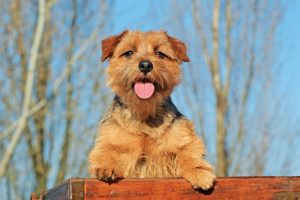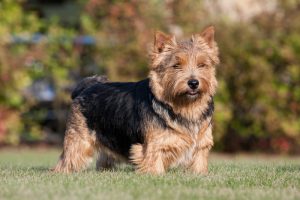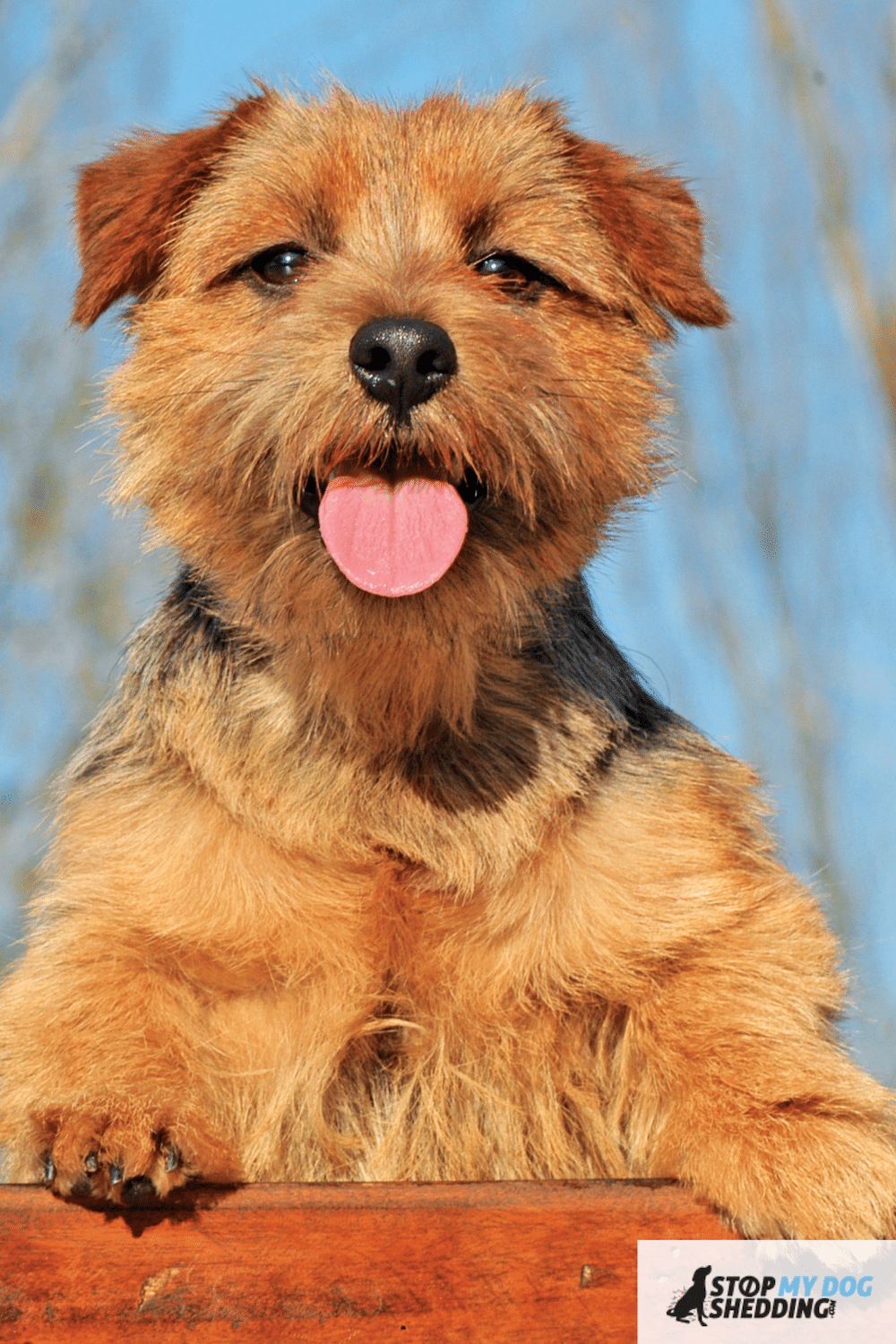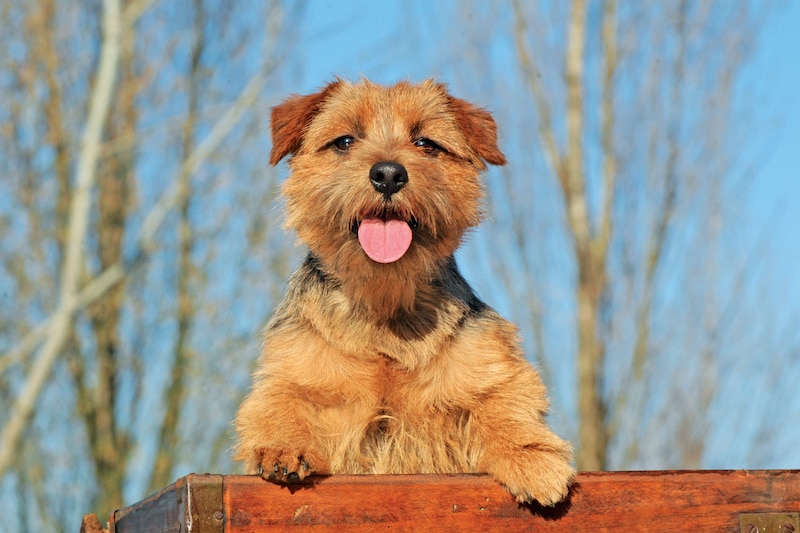The Norfolk Terrier is a small British dog that was bred to hunt vermin and catch foxes. They are best known for being fearless, energetic and adventurous family companions.
How much do they shed? Norfolk Terriers are a low shedding breed. They have a short-medium outer coat that is made up of harsh, wiry hairs and a soft undercoat. Because they’re a double coated breed, they typically shed more during spring and fall, but regular brushing can keep your home fur free.
Let’s explore further what you can expect when it comes to shedding, what sort of grooming they require and what makes Norfolks such great dogs.
Recommended: Go here to see our top-rated dog hair blow dryers
Norfolk Terrier Shedding
Norfolk Terriers are a low shedding breed.
To help put this into perspective, they shed about the same as the Soft Coated Wheaten Terrier, a bit less than a Fox Terrier, and a lot less than a Pug.
So, throughout the year, you will notice some hair floating around the home. Which will mean some extra vacuuming, but nothing too extreme in comparison to many other breeds.
With that being said, they are double coated, which means they are subject to seasonal shedding. This typically occurs during spring and fall when they shed their winter or summer coat in preparation for the coming change of season.
It’s not very extreme with a Norfolk Terrier though, especially not when you consider that they are one of the smallest terriers on record at the AKC.
Small dogs shed, make no mistake about it. But the smaller the dog is in size, the less hair they have to lose in comparison to a larger breed overall.
This is because shedding is the result of the natural hair growth cycle where hair grows, stops growing and then falls out. The physical size of the dog doesn’t change this process but logically the bigger the dog the more hair it has to lose.
Either way, aside from a bit of an uptick in shedding a couple times per year, the amount of fur Norfolk Terriers lose is very low.
Recommended: Go here to see our top-rated dog hair blow dryers
Are Norfolk Terriers Hypoallergenic?
Yes. Norfolk Terriers are considered to be a hypoallergenic breed because they don’t shed very much and don’t leave a lot of dander floating around.
The term “hypoallergenic” when used to describe a dog breed is a bit controversial though. Because, quite simply, no dog is ever completely hypoallergenic. Even completely hairless breeds can cause some people irritation.
And this is because the allergies don’t come from the hair itself, they mostly come from the dogs dander (dead flaking skin). This, along with their dried saliva, attaches itself to the hair which helps to spread these allergens when they shed.
So, generally speaking, the less they shed, the more hypoallergenic they are, which is one of the main reasons why Norfolk Terriers are considered non-allergenic.
Recommended: Go here to see our top-rated dog hair blow dryers
Brushing Your Norfolk Terrier to Reduce Shedding
Brushing your Norfolk Terrier is a fairly simple task and is one of the best ways to limit how much hair they shed, and therefor how much time you’ll spend cleaning it up.
The reason for this is twofold.
The first and most obvious reason is because you’re removing the loose fur from the source before it falls out. And the second, less obvious, reason is because brushing can help prevent dry skin, which in itself can cause shedding.
The reason for this is because brushing promotes moisture in the skin and helps to distribute his natural coat oils. Which promotes a healthy, moisture rich coat. And this, in turn, can reduce excessive shedding caused by dryness.
What sort of brush should you use?
It really comes down to personal preference when choosing a brush for your dog. However, a slicker brush works well for a Norfolk, in conjunction with a metal comb or deshedding tool.
The slicker is best for the outer coat as it makes short work of matts and tangles and removes the bulk of dead hair. So it’s best to start with this. And the metal comb (or some prefer a deshedding tool) works well for the undercoat as it reaches right down to remove that loose fur.
Shedding tools are more effective than a basic comb, and can save you some time in the long run, but they are more expensive. So you really need to decide based on your own circumstances.
Check out our dog brush reviews and buyer’s guide to learn more.
Also worth noting is that some people like to hand strip their Norfolk Terrier, which is basically a process of stripping out loose hairs by hand or with a stripping tool. But this isn’t necessary unless he’s a show dog or you’re really fussy about how his coat looks. It’s also not very pleasant for the dog.
In any case, you really only need to brush once a week or so to maintain his coat. But if you’re noticing more floating around than you’d like, brushing every day (or every other day) can make a huge difference.
All dogs shed, so you can’t stop it, but a simple grooming regime can significantly reduce it. And there are some other great ways to reduce shedding besides brushing which together with brushing can help you win the battle.
Is a Norfolk Terrier Right for You?
Norfolk Terriers are small working dogs that originate from Norwich, where they were originally bred to hunt vermin and catch foxes.
According to some experts, they are closely related to the Glen of Imaal, Cairn and Border terriers. And at one point they were considered the same breed as the Norwich Terrier. So much so that it wasn’t until the 1960’s that they were officially recognized as a distinct breed in England and even later in the United States.
It’s not that difficult to tell them apart though, all you really need to do is look at their ears. The Norwich Terrier has erect ears, while the Norfolk Terrier has folded ears.


Norfolk Terriers might be small, but they’re just as fearless, fun loving and independent as any large terrier. And they’ve become popular family companions over time as a result.
They love people (including children) and are typically good around other dogs and even cats. This is because they were pack hunters back in the day where they had no choice but to get along.
With that being said, their natural hunting instincts can cause problems around small animals like birds and mice, so this is something to keep in mind.
All in all, if you’re looking for a low shedding dog that is fairly low maintenance overall, then the Norfolk Terrier will make a welcome addition to your family.













Please note: By submitting a comment using the above comment form, you confirm that you agree with the storage and handling of your data by this site as detailed in our Privacy Policy.